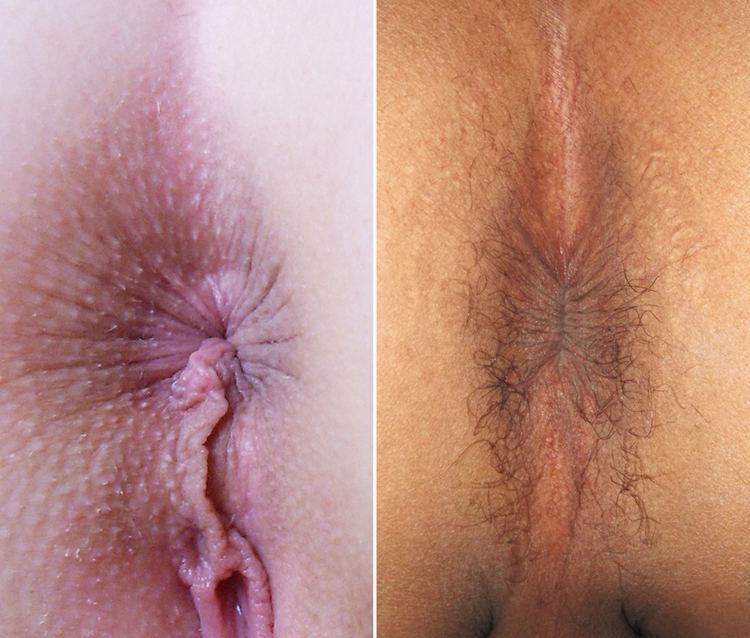TA A05.7.05.013 | FMA 15711 | |
 | ||
The human anus (from Latin anus meaning "ring", "circle") is the external opening of the rectum. Two sphincters control the exit of feces from the body during an act of defecation, which is the primary function of the anus. These are the internal anal sphincter and the external anal sphincter, which are circular muscles that normally maintain constriction of the orifice and which relaxes as required by normal physiological functioning. The inner sphincter is involuntary and the outer is voluntary. It is located behind the perineum which is located behind the vagina in females and behind the scrotum in males.
Contents
- Structure
- Histology
- Development
- Defecation
- Clinical significance
- Psychology
- Sexuality
- Hygiene
- Cosmetics
- References
With anal sex, the anus can play a role in sexuality. Attitudes towards anal sex vary and it is illegal in some countries. The anus is often considered a taboo part of the body, and it is known by a large number of usually vulgar slang terms. The anus is also the site of potential infections and other conditions, including cancer. The traditional polite synonym for anus was fundament, though this euphemism is rarely heard now that medical terms are widely acceptable.
Structure
The anus is the final component of the gastrointestinal tract, and directly continues from the rectum. The anus passes through the pelvic floor. The anus is surrounded by muscles. The top and bottom of the anus are surrounded by the internal and external anal sphincters, two muscular rings which control defecation.
The anus is surrounded in its length by folds called anal valves, which converge at a line known as the pectinate line. This represents the point of transition between the hindgut and the ectoderm in the embryo. Below this point, the mucosa of the internal anus becomes skin. The pectinate line is also the division between the internal and external anus.
The anus receives blood from the inferior rectal artery and innervation from the inferior rectal nerves, which branch from the pudendal nerve.
Histology
The pseudostratified columnar epithelium of the gastrointestinal tract transitions to stratified squamous epithelium at the pectinate line. The stratified squamous epithelium gradually accumulates sebaceous and apocrine glands.
Development
During puberty, as testosterone triggers androgenic hair growth on the body, pubic hair begins to appear around the anus. Although initially sparse, it fills out by the end of puberty, if not earlier. However, in some genetic populations androgenic hair is less common.
Defecation
Intra-rectal pressure builds as the rectum fills with feces, pushing the feces against the walls of the anal canal. Contractions of abdominal and pelvic floor muscles can create intra-abdominal pressure which further increases intra-rectal pressure. The internal anal sphincter (an involuntary muscle) responds to the pressure by relaxing, thus allowing the feces to enter the canal. The rectum shortens as feces are pushed into the anal canal and peristaltic waves push the feces out of the rectum. Relaxation of the internal and external anal sphincters allows the feces to exit from the anus, finally, as the levator ani muscles pull the anus up over the exiting feces.
Clinical significance
Psychology
In psychology, the Freudian term anal fixation is used.
Sexuality
The anus has a relatively high concentration of nerve endings and can be an erogenous zone, which can make anal intercourse pleasurable. The pudendal nerve that branches to supply the external anal sphincter also branches to the dorsal nerve of clitoris and the dorsal nerve of penis.
Sigmund Freud's theory of psychosexual development, for example, described an anal stage, hypothesizing that toddlers derive pleasure from retaining and expelling feces. This is the source of the term "anal-retentive" and the derived informal term "anal".
In addition to nerve endings, pleasure from anal intercourse occurs due to the shared wall between the anus and the prostate for males and vagina/G-Spot for females. This allows for indirect stimulation of the G-Spot or clitoral legs in women, and prostate in men. For a male insertive partner, the tightness of the anus can be a source of pleasure via the tactile pressure on the penis. Pleasure from the anus can also be achieved through anal masturbation, fingering, fisting, facesitting, anilingus, and other penetrative and non-penetrative acts. Anal stretching can stimulate the nerves around the anus and can be considered pleasurable. Care must be taken to maintain elasticity. Lubricant is widely regarded as a necessity while performing anal sex.
Anal intercourse is sometimes referred to as sodomy or buggery, and is considered taboo in a number of legal systems. It has been, and in some jurisdictions continues to be, a crime carrying severe punishment.
Hygiene
To prevent diseases of the anus and to promote general hygiene, humans often clean the exterior of the anus after emptying the bowels. A rinse with water from a bidet or a wipe with toilet paper are often used for this purpose, though anal cleansing practices vary greatly between cultures.
Cosmetics
Shaving, trimming, depilatory (hair removal), or Brazilian waxing can clear the perineum of hair.
Anal bleaching is a process in which the anus and perineum, which may darken after puberty depending on individual genetics, is lightened for a more youthful appearance.
True anal piercing is rare because it may interfere with the function of the anus. However, surface piercings of the perineum are easier to care for and much more common.
